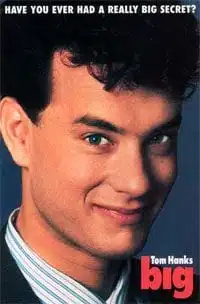
The movie-going public was inundated with body-switching films at the end of the ’80s. Like Father Like Son set off the run of releases in October 1987, then from March through June 1988, Vice Versa, 18 Again, and Big were unleashed in quick succession. The diversity of the actors involved (Dudley Moore, Kirk Cameron, Judge Reinhold, Fred Savage, George Burns, Charlie Schlatter, and Tom Hanks) provide an interesting cross-section of late ’80s popular culture, but none of these films are memorable enough to warrant anything more than a line item on the actor’s IMDb profile or a mocking nod on VH1’s indulgent I Love the ’80s series.
Except Big. The first of this spat of body swap movies to be greenlit by a studio, and the last to make it to the screen, Big has the distinction of being the only one of the bunch nominated for two Academy Awards: Best Writing, Original Screenplay for Gary Ross and Anne Spielberg, and Best Actor in a Leading Role for Hanks.
With Big, Ross, who would go on to adapt the screenplay for and direct Seabiscuit, and Spielberg (yes, Steven’s little sister) provide a solid first-ever attempt at scriptwriting that is ruled as much by emotion as it is by its comedic queues. When 13-year-old Josh’s wish to be big is granted by a Zoltar Speaks carnival machine overnight, his life is thrown into turmoil. Thinking his grown version is a home-invader, his mom (played by Mercedes Ruehl) chases him out of the house and he heads to New York City with his best friend Billy in an attempt to find a way to reverse the spell.
In order to survive in the city until the carnie machine can be located, Josh puts his late ’80s computer prowess to work as a data entry clerk at MacMillan Toys. The brilliance of the script is how it illustrates Josh’s loss of childhood, but not his loss of innocence in a Chance the Gardener kind of way. And that innocence protects him from the corporate politics in the form of the just-threatening-enough John Heard, saves Elisabeth Perkins’ love interest Susan from the pitfalls of big business yuppy-dom, and restores company owner Robert Loggia’s faith in why he got into the toy making business in the first place.
Big is the kind of movie that is sold to a studio on its premise, but bought by the public on the performance of the main character. Hanks, in a dry spell somewhere between his big screen debut in Splash and his critical acclaim from Philadelphia, is a thoroughly convincing 13 year-old. The physical humor is spot-on and the situational comedy is well-crafted without pandering, but it’s the emotion Hanks is able to convey that convinces the viewer to completely buy in. The fear expressed in his mannerisms and facial expressions when he finds himself alone in the St. James, a pre-Giuliani Times Square clean-up flophouse (which Billy assures him is OK because, you know, “St. James, Josh. It’s religious.”) is heartbreakingly real. It is surely this performance that kept Hanks’ career buoyant during that stretch of Bachelor Party, The Man with One Red Shoe, Volunteers, The Money Pit, Nothing in Common, Dragnet, The ‘burbs, Turner & Hooch, and Joe Versus the Volcano. Dubious company for Big to say the least.
Also of significance is Big‘s launching of Penny Marshall’s directorial career. Sure, she directed Whoopi Goldberg in Jumpin’ Jack Flash, but that was after stepping into the project as a replacement director. Here, Marshall was producer James L. Brooks’ first choice behind the camera, and it paid off. Marshall was able to coax an evocative performance from the child actors and from Hanks. She actually videotaped David Moscow (young Josh in the movie) doing every one of Hanks’ scenes so the actor had a point of reference on which to base his character. It is this kind of attention to detail that gives Big its staying power.
The newly released two-disc Extended Edition DVD gives fans plenty to appreciate. Disc one includes two versions of the film: the original theatrical release and the extended cut with eight deleted scenes restored (the deleted scenes are also available separately on disc two, with optional, and pointless, introductions by director Marshall). The audio commentary, which is available only with the theatrical release, is truly unique. It is framed by Ross and Spielberg, who share the audio tape recordings they made as they brainstormed the original idea for the movie. This, combined with the excess of information on disc two, provides a thoroughly satisfying experience. “‘Big’ Beginnings” provides background on Ross, Spielberg, and Brooks’ efforts to conceive, create, and bring to life the story, and “Chemistry of a Classic” catches up with all the principals except Hanks. “The Work of Play” is needless information about what its like to work for a real toy company, but the AMC “Hollywood Backstory” episode on Big is presented in its entirety. “Carnival Party Newswrap”, much like the two trailers and two TV spots included, is a quick snapshot into late ’80s culture. Rounding things out are trailers for four more Hanks movies of varying quality, and one for the direct-to-DVD sequel The Sandlot: Heading Home (the connection to Hanks, Marshall, or anyone else involved in Big escaped me).
In all, the set does not feel bloated with filler, nor as if the goodies were spread too thinly across multiple discs only to garner a higher price tag. It will reward the double-dippers and the first-time buyers alike. There’s a reason movies like Big have staying power, and though the Big: Extended Edition release is about the movie’s charm first and foremost, it doesn’t forget to compensate the fan.

